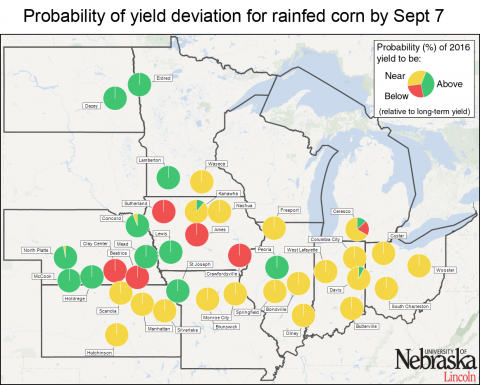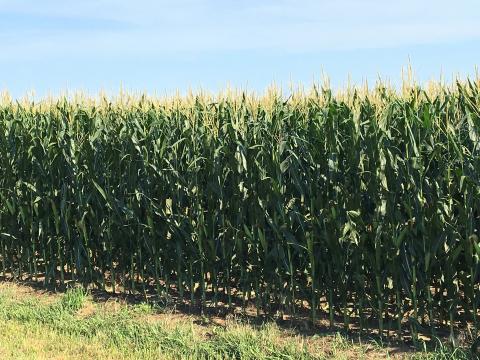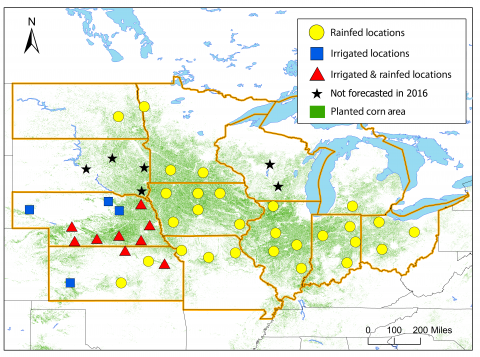Help Us Identify Yield-Limiting Factors in Nebraska Soybean Fields
October 5, 2016
Nebraska soybean producers are being asked to answer a survey about their soybean fields and contribute to a benchmark study of current soybean production in Nebraska. Researchers from 10 north central states, including Nebraska, are collecting the data to identify factors that may be impeding growers from reaching full yield. See what they've learned in the first two years of the study and how they hope to use the information.
Yield Forecast Center Predicts Corn Yields Well Below USDA-NASS Projections
September 22, 2016
End-of-season yield forecasts for irrigated and dryland corn across eight states in the Corn Belt indicate above average yields for 2016, but not the record-breaking yields predicted by USDA in their September forecast. While two states are forecast to have yields below the 10-year average (-1% to -4%), the remaining states showed above average yields ranging from 1% to 21% above the 10-year average.
Corn Yield Forecasts as of Sept. 7
September 8, 2016
The Sept. 7 corn yield forecasts show a majority of the irrigated sites expected to produce above normal, but not record-breaking yields. Forecasted yields for rainfed sites are more variable, although most are expected to be near normal. Above average yields are expected for 11 of the 37 sites studied and below-normal yields are forecast for five sites.
Corn Yield Forecasts for Aug. 24, Including State Forecasts
August 25, 2016
August 24 corn yield forecasts for 41 sites across the Corn Belt showed many near or above average. At Nebraska rainfed corn sites there is a high probability (>75%) of above-average yield at the North Platte and central east sites and a high probability (>75%) of below-average yield at the southwestern and southeastern Nebraska sites (McCook, Clay Center, and Beatrice). In irrigated corn there was a high probability of near or above average yields for all except the Beatrice site. See the story for data tables and discussion.
2016 Corn Yield Forecasts as of Aug. 10
August 11, 2016
Simulations of 2016 end-of-season corn yield potential for 41 sites indicate high probability of near or above-average yields in irrigated fields, but much more variability across the Corn Belt for rainfed fields. Several sites in southern and northeast Nebraska and in Iowa show a higher probability of below average yields. The article includes yield forecasts for each site, along with conditions for the period contributing to the forecasts.
2016 Corn Yield Forecasts as of July 27
July 28, 2016
Corn yield forecasts, based on Hybrid-Maize simulations and input from crop experts in 10 states, were developed for 41 sites across the Corn Belt on July 27. For irrigated corn, based on this conditions at this point in the season, there is only a low probability of below average yields. For rainfed corn, the majority of the sites studied, the results are more variable across locations. The article includes yield forecasts for each site, along with conditions for the period contributing to the forecasts.
2016 Corn Yield Forecasts as of July 13
July 14, 2016
Based on modeling corn growth stage and end-of-season yield for 41 sites in 10 Corn Belt states, researchers are forecasting potential end-of-season yield in "real time" to aid in decision-making thoughout the season. On July 14 they reported that corn has already reached or is approaching silking throughout most of Nebraska and the Corn Belt, except for corn in the northern and eastern states, where growth is running behind the rest of the region.based on modeling end-of-season corn yield for 41 sites. There is a low (<20%) probability of below-average yields at all irrigated locations, except for two sites in southeastern Nebraska. The range of forecast yields at the rainfed sites is wider. There is a relatively high probability (>75%) of above-average yield at two locations in the northern states and below-average yield at three locations. See story for predicted yields and probabilities for all the sites.
2016 Corn Yield Forecasts: Approach and Interpretation of Results
June 30, 2016
The Yield Forecasting Center will be providing in-season corn yield forecasts every two weeks starting in mid-July to aid growers and the ag industry in making management, logistics, and marketing decisions through the season. The Center consists of a core team at UNL in collaboration with agronomists and extension educators from universities throughout the Corn Belt.








